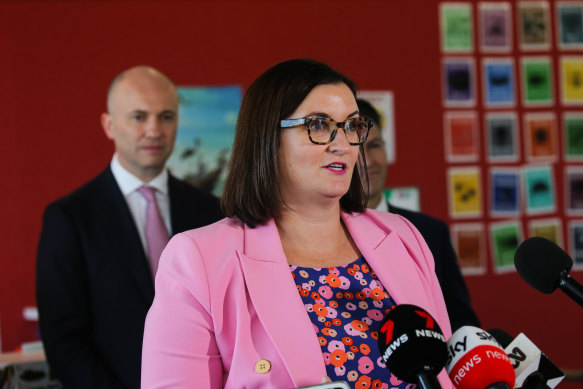By Lucy Carroll
The NSW government will launch an aggressive push to draw more graduate teachers into the public system as schools face major staff shortages with vacancies hitting almost 1700.
It comes amid concerns from education experts that private schools are scooping up top teaching graduates with higher pay and less casual work.

“We need to be doing a better job of promoting the benefit of a career in NSW public education”: Education Minister Sarah Mitchell.Credit: NCA Newswire/ Gaye Gerard
Fifty public schools have five or more full-time teacher vacancies, data from June shows, including at major city schools including Chester Hill High, Killara High, Northern Beaches Secondary College Cromer Campus and Plumpton High. Figures from NSW Department of Education show a total of 1657 vacancies as of June 10.
“The department should be chasing and directly recruiting new graduates, specifically those in high-need areas,” Education Minister Sarah Mitchell said. “We are the biggest employer of teachers in the country, and we need to be doing a better job of promoting the benefit of a career in NSW public education. I want public schools to be the first choice for all new teacher graduates.”
The head of the University of Sydney’s school of education, Deb Hayes, flagged concerns that graduate teachers who land jobs at public schools are stuck in long-term casual work.
“Teaching graduates need earlier offers for secure work in public schools. The real issue is teaching graduates who are committed to public schools do not believe that the public system is committed to them,” she said.
Hayes said private school principals have more flexibility to offer stable employment and can snap up graduates during the gap between finishing their degree and starting work.
NSW will need an additional 3800 teachers to meet demand to 2027, while shortages are biting across all sectors including in subjects such as English and physical education that once had plenty of staff.
Mitchell said a NSW advertising blitz would be launched later this year as part of a drive to lure more new graduate teachers into the public system.
“Giving students earlier access to schools during their training will make them better teachers and help them build better relationships with schools, which we can leverage to provide earlier employment offers,” Mitchell said.
Federal and state education ministers will meet in August to discuss a national approach to tackling the teacher shortage and a potential overhaul to training.
Former federal Education Department secretary Lisa Paul, who will address the meeting, said the “best and brightest school-leavers should be falling over each other trying to become teachers. It should be the most sought after job.”
Paul, who chaired a review into teacher education, urged state education ministers to implement all 17 recommendations, which she said will “go a long way to help solve the problem of significant teacher shortages”.
“The status of teaching needs to be lifted. Red tape and the burden of admin work must be reduced. Scholarships and other financial incentives must be brought in for high-achieving school graduates and mid-career changers,” Paul told the Herald.
“Universities have a huge role in and massive responsibility in making sure the people they are teaching to be teachers are most likely to succeed. I’ve told vice-chancellors there is a real sense of urgency about this,” Paul said.
Data from June shows there are 18 unfilled positions at Chester Hill High, which has around 1100 students and a full-time equivalent allocation of about 100 teachers. There are at least eight vacant positions at Killara High, Northern Beaches Secondary College Cromer, Epping Public School and Plumpton High.
Shortages are being sharply felt in regional and rural areas: at Walgett Community College, a school of about 120 students, has 10 empty positions, the department figures show. At Dubbo College Delroy Campus there are 12 positions unfilled at the school which has about 56 full-time equivalent teaching staff. Gunnedah, Kotaro and Monaro high schools have at least seven vacancies each.
NSW Teachers Federation President Angelo Gavrielato said there were fundamental and structural problems that have resulted in the teacher shortage.
“No amount of advertising will deal with the structural issue of uncompetitive salaries and unsustainable workload. We have a crisis that will only get worse,” he said.
Despite a major push to fast-track teacher visas, data from the Department of Home Affairs shows there are fewer than 60 applications for teachers waiting to be processed in the temporary skills shortage visa category nationally.
In the past 18 months, about 140 applications for primary and secondary school teachers have been granted. Just over 30 were for school teachers who wanted to work in NSW.
A spokesperson for NSW Education said the public education system has a staff vacancy rate of around 3.6 per cent, which is “very low for a system of our size”.
“Seventy four per cent of schools have no vacancies, or only one. Our $125 million teacher supply strategy has a range of initiatives to make sure we have the quality teachers we need, in the right subjects and the right locations,” the spokesperson said.
The Morning Edition newsletter is our guide to the day’s most important and interesting stories, analysis and insights. Sign up here.